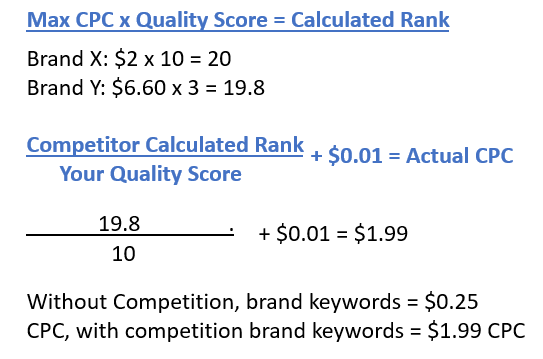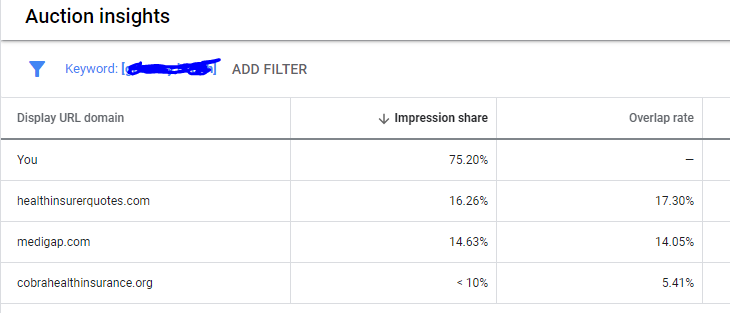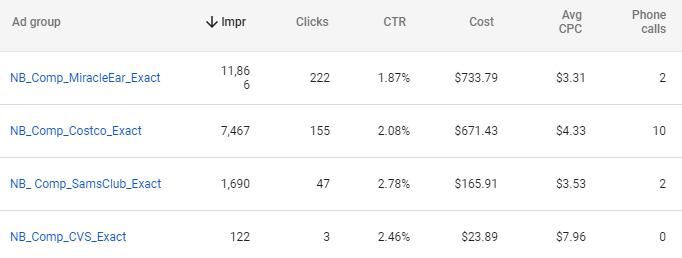As you may know, competitor bidding is the practice of actively bidding on your competitors’ brand name keywords.
This particular search marketing tactic has been around on Google since the late ’00s; prior to that, it wasn’t allowed (by Google, at least — Yahoo! always allowed it).
Competitor bidding can throw the SERP into a bit of chaos for the other brands — and possibly back on you, as well.
In this post, you’ll learn how to use competitive bidding in SEM to your advantage, which includes avoiding any unintended consequences.
What Happens When You Bid Competitively
The outcome of this tactic, as the article name reflects, often leads to a chaotic scenario. The level of impact is often dependent on why the advertiser is trying to creep on their competitors.
But no matter the reason, it is not going to be a directly profitable scenario for you.
While competitor bidding will drive up the competitor’s cost, if you really anger a big brand it may come back to bite you in the rear.
From a monetary or quantitative standpoint, the impact is clearer and more direct.
Let’s say someone is bidding on your brand name. In this example:
- You are Brand A.
- The word is [x].
- You have a quality score (QS) of 10.
- And the bid is $2, so your calculated rank is 20.
Right now, you’re paying about $0.25, as there is no real competition. Along comes competitor Brand B, who starts to bid on the word [x].
They have a low QS; say a 3.
However, their bid is $6.60 which brings Brand B’s calculated rank to 19.8. Because of this entry point on that keyword and that bid, your average CPC for Brand A rises to a whopping $1.99, all without the competitor leapfrogging you.
That is what they did to you, so how do you think they will act if you do it to them? Is the juice worth the squeeze?
 Quick refresher on how to calculate CPC
Quick refresher on how to calculate CPCYes, competitor bidding does equal chaos. And typically, the bidder with the deepest pockets and best resources comes out the winner (survivor).
Why Do Brands Bid Competitively?
The logic as to why can vary. There are several different reasons, but ultimately it comes back to one of 4 reasons:
- Your Ego: You have an ego, and it’s influencing this move. It happens to the best of us.
- Warning Shot: Your competitor is bidding on you, and you want to “fire a warning shot across the bow” to encourage them to back off.
- Brand Awareness: Your competitor is a market share leader and you want to create brand awareness for yourself.
- Riding Media Coattails: Your competitor is running strong media (usually TV, radio, print), so you wish to ride its coattails and reap some secondary benefits.
Some of these reasons have some legitimate degree of justification; others do not.
If your purpose is #1, just don’t do it. Save yourself the time and energy.
If your purpose is #2, consider that this could easily backfire on you and is only advisable in extreme scenarios.
If your purpose is #3 or #4, your chaos will be controlled. But keep in mind that the goal in those scenarios is a long game. There will be little to no immediate gratification.
How Do I Effectively Practice Competitor Bidding?
Let’s walk through it based on the motivation you identified above.
Your Ego
This will not end well for you. I can’t assist.
Warning Shot
First, confirm that your competitors are consistently bidding on your brand keywords. I recommend looking at your short tail, exact match keywords via auction insights.
Pay attention to who has a high Impression Share and Overlap Rate. Monitor their behavior for 1-2 weeks prior, by day, to confirm there is a clear intent in what they’re doing.
Once confirmed, begin to bid on mid to short tail keywords of their brand name in exact match. Assume your QS will be a 3 or less, which means your bid needs to be 2x that of a non-brand bid.
Then sit and wait for up to a week. Monitor your brand keywords and see if they back off. If they do, you should stop.
You can try a target impression share bid strategy here, but it could get unnecessarily costly (and this tactic is already costly).
 Auction insights report in Google
Auction insights report in GoogleBrand Awareness
This only makes sense if you pursue the market leaders. If you aren’t sure who they are, don’t do it.
In verticals highly saturated with competition, you’re less likely to get retribution from the leaders vs. in verticals with less competition.
Identify the leader(s) you want to target (don’t do too many, it can get pricey) and utilize a walk-up bid strategy on them.
Start out with a moderate bid — say $0.25-$0.50. Remember, the goal isn’t to be first. It’s to be visible.
Slowly walk the bid up once a week until you start to leapfrog the market leader consistently. Once that happens, back the bid down a bit. Monitor your Impression Share when you hit that upper limit.
After you’ve backed off, move to a top-of-page Impression Share Strategy, with a max CPC 5%-10% below your upper cap.
It’ll be most effective for visibility, without going past the leader and really jacking up the price.
For less competitive verticals, use a max click strategy. You will more easily show at the top of the page but the pricing isn’t determined by trying to be a front runner. It’ll be more cost-efficient for that reason.
 Competitive bidding ad groups
Competitive bidding ad groupsRiding Media Coattails
This is the only reason I consistently endorse for proceeding with competitor bidding. It’s just flat-out smart SEM.
Let’s be honest — if you’re competitive bidding, odds are you can’t afford TV, radio, and/or print.
But if the competition can, specifically at a national or regional level that you’re in, then do it.
Use third-party tools or simply watch TV to see what your competition is doing. If they have a campaign you want to take advantage of, be strategic about it.
Bid on their name but try to incorporate as much of their messaging into your ad copy as possible. This gives the less discerning customer the message that you also will serve their need.
Clearly monitor the competitor’s media. Once their campaign ends, pull back or pull out as the benefit you were coasting on has likely disappeared.
How Do I Know if My Competitor Bidding is Working?
This is a loaded question, and we’re going right back to the reason you’re doing this in the first place.
If It’s for Ego
Just don’t do it. Have I gotten that across yet?
If It’s a Warning Shot
Success is based on what stops happening. You’re doing this to let a competitor know you caught them bidding on you.
The hope and dream are that their team is sophisticated enough to catch this, and they back off bidding on you. If they stop, I recommend you stop, as well.
Then we all go back to being friends, sing kumbaya, and go our separate ways.
If It’s for Brand Awareness
Success is fairly easy to measure (note: measure does not mean attain). The primary goal is to monitor CTR. It should beat out your high-volume, non-brand keywords but still come in below your brand keywords.
Secondary are your on-site KPIs beyond simple conversions, such as micro-conversions, page depth, and time on site.
If It’s for Riding Media Coattails
Ignore CTR. Volume will come in high, at the risk of collateral damage to your competitor. You need to focus on your primary KPIs: onsite behavior, conversions, and engagement.
If you expect to make a positive last click return in an ecommerce or direct response perspective by bidding on your competition, you are mistaken. You will not be successful.
Accept that and move on, or change your purpose and goal for doing it. At best, this will aid in a lifetime value scenario.
Important Tips for Successful Competitor Bidding Strategy
Disclaimer: I’m not a lawyer. Please consult with your own legal counsel.
But I do know what collusion and anti-competitive practices mean.
If you get the idea of reaching out to a competitor to discuss bidding/not bidding on one another, DON’T!
You aren’t the first to come up with this idea.
What I can tell you is that this can be held against you in a federal case. Don’t believe me? Just ask 1800 Contacts.
Competitor bidding is unrestricted at the keyword level. At the ad copy level, it gets a bit gray.
If a brand files its trademark with the search engine, a competitor’s ad will be disapproved if they add the competitor’s name in the ad copy.
If the trademark was never filed with the engine, the competitor’s name can be added to the ad copy. However, there’s a chance your office will receive a cease and desist letter (trust me, I’ve received 5 in 16 years for this).
There is a unique workaround that gets past the engine’s trademark rules: Non-English characters replacing letters. Perfect example: “Jon Corp” is trademarked, but it can be written as “Jοn Cοrρ.”
In this example the letter O has been replaced by the lower case Greek letter of omicron and the letter P has been replaced by the lower case Greek letter of rho.
They render in the engine identically but meet trademark requirements (note: still may not be worth a cease and desist letter).
 Left side is all English, right side is English and Greek
Left side is all English, right side is English and GreekCompetitor bidding should not be where your first dollar goes. It doesn’t make fiscal sense.
Realistically, this is a tactic to try after all other efforts (i.e., brand, non-brand, shopping, etc.) have been done first.
In Conclusion
If you plan to bid competitively, prepare for chaos.
Prepare for high costs, and return that will not come immediately.
For a lesser-known brand, competitor bidding can pay dividends — if you’re willing to make the fiscal sacrifices upfront.
More Resources:
- What to Do When Competitors Buy Your Brand Keyword
- Why Bidding On Your Brand Name is Important
- PPC 101: A Complete Guide to PPC Marketing Basics
Image Credits
All screenshots taken by author, May 2021





